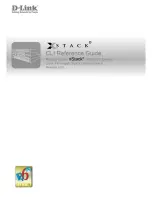
Chapter 5
| VLAN Configuration
IEEE 802.1Q Tunneling
– 167 –
A service provider’s customers may have specific requirements for their internal
VLAN IDs and number of VLANs supported. VLAN ranges required by different
customers in the same service-provider network might easily overlap, and traffic
passing through the infrastructure might be mixed. Assigning a unique range of
VLAN IDs to each customer would restrict customer configurations, require
intensive processing of VLAN mapping tables, and could easily exceed the
maximum VLAN limit of 4096.
QinQ tunneling uses a single Service Provider VLAN (SPVLAN) for customers who
have multiple VLANs. Customer VLAN IDs are preserved and traffic from different
customers is segregated within the service provider’s network even when they use
the same customer-specific VLAN IDs. QinQ tunneling expands VLAN space by
using a VLAN-in-VLAN hierarchy, preserving the customer’s original tagged
packets, and adding SPVLAN tags to each frame (also called double tagging).
A port configured to support QinQ tunneling must be set to tunnel port mode. The
Service Provider VLAN (SPVLAN) ID for the specific customer must be assigned to
the QinQ tunnel access port on the edge switch where the customer traffic enters
the service provider’s network. Each customer requires a separate SPVLAN, but this
VLAN supports all of the customer's internal VLANs. The QinQ tunnel uplink port
that passes traffic from the edge switch into the service provider’s metro network
must also be added to this SPVLAN. The uplink port can be added to multiple
SPVLANs to carry inbound traffic for different customers onto the service provider’s
network.
When a double-tagged packet enters another trunk port in an intermediate or core
switch in the service provider’s network, the outer tag is stripped for packet
processing. When the packet exits another trunk port on the same core switch, the
same SPVLAN tag is again added to the packet.
When a packet enters the trunk port on the service provider’s egress switch, the
outer tag is again stripped for packet processing. However, the SPVLAN tag is not
added when it is sent out the tunnel access port on the edge switch into the
customer’s network. The packet is sent as a normal IEEE 802.1Q-tagged frame,
preserving the original VLAN numbers used in the customer’s network.
Figure 82: QinQ Operational Concept
Tunnel Uplink Ports
Double-Tagged Packets
Outer Tag - Service Provider VID
Inner Tag - Customer VID
QinQ Tunneling
Service Provider
(edge switch A)
Customer A
(VLANs 1-10)
Customer B
(VLANs 1-50)
Customer A
(VLANs 1-10)
Customer B
(VLANs 1-50)
Service Provider
(edge switch B)
VLAN 10
Tunnel
Port
Access
Tunnel
Port
VLAN 20
Access
VLAN 10
Tunnel
Port
Access
Tunnel
Port
VLAN 20
Access
Summary of Contents for GTL-2881
Page 34: ...Section I Getting Started 34 ...
Page 48: ...Section II Web Configuration 48 Unicast Routing on page 651 ...
Page 151: ...Chapter 4 Interface Configuration VLAN Trunking 151 Figure 69 Configuring VLAN Trunking ...
Page 152: ...Chapter 4 Interface Configuration VLAN Trunking 152 ...
Page 230: ...Chapter 8 Congestion Control Automatic Traffic Control 230 ...
Page 596: ...Chapter 14 Multicast Filtering Multicast VLAN Registration for IPv6 596 ...
Page 620: ...Chapter 15 IP Configuration Setting the Switch s IP Address IP Version 6 620 ...
Page 672: ...Section III Appendices 672 ...
Page 678: ...Appendix A Software Specifications Management Information Bases 678 ...
Page 688: ...Appendix C License Statement GPL Code Statement Notification of Compliance 688 ...
Page 696: ...Glossary 696 ...
Page 706: ...GTL 2881 GTL 2882 E112016 ST R01 ...
















































